Individual Society Analysis Report - Group Dynamics and Video Analysis
VerifiedAdded on 2021/04/17
|7
|2030
|26
Report
AI Summary
This report analyzes group dynamics and conflict resolution in various settings. It begins with an examination of group interaction, preparedness, and participation, followed by an analysis of a group discussion's climate and productivity. The report then delves into two video analyses: the first focuses on planning a playground, examining issues, group effectiveness, constructive and deconstructive conflict, and alternative approaches. The second video explores the 'Politics of Sociology,' addressing curriculum issues, group performance, conflict types, and leadership roles. The report concludes by providing strategies for future group discussions and cohesion, offering valuable insights into effective team communication, leadership, and conflict management.
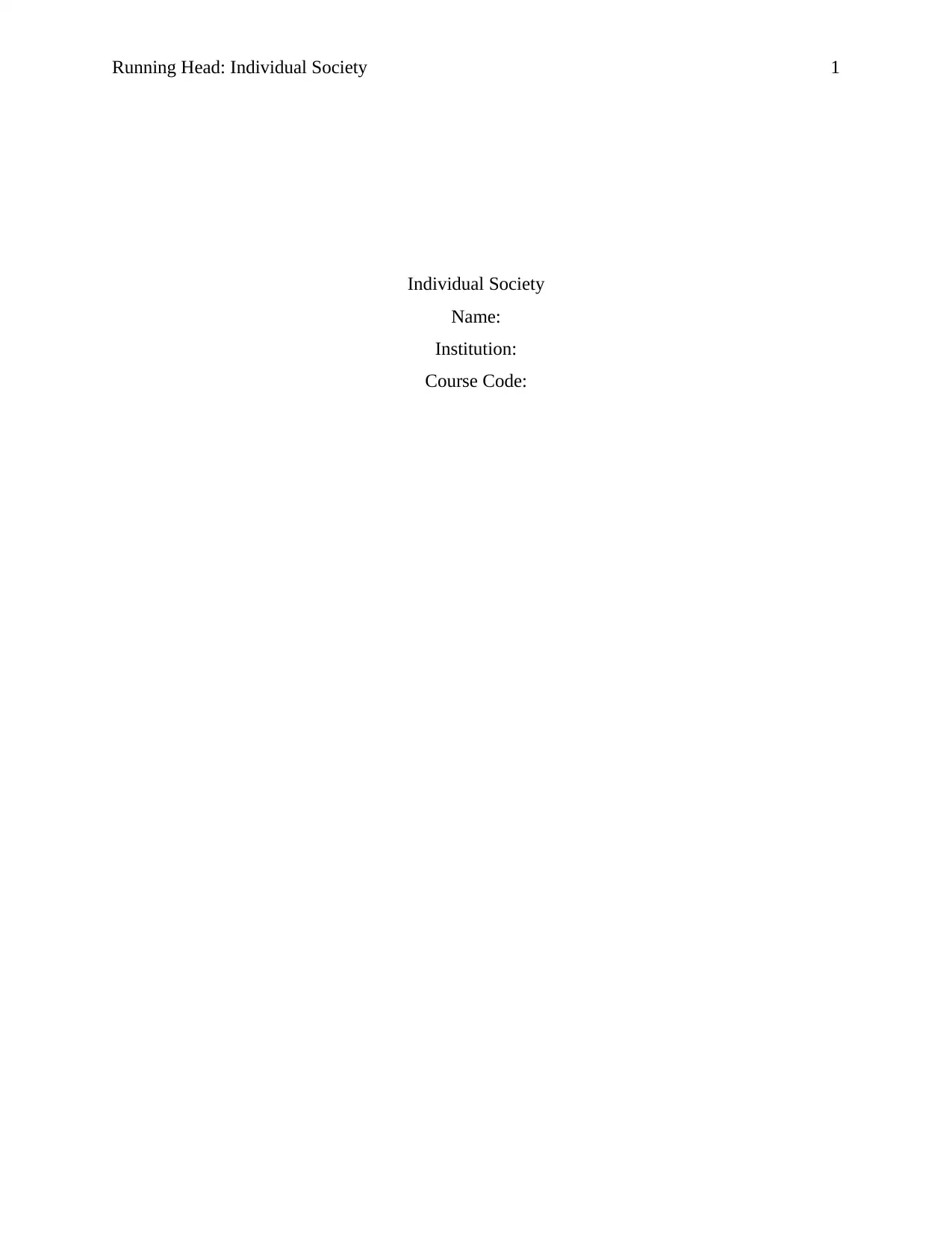
Running Head: Individual Society 1
Individual Society
Name:
Institution:
Course Code:
Individual Society
Name:
Institution:
Course Code:
Paraphrase This Document
Need a fresh take? Get an instant paraphrase of this document with our AI Paraphraser
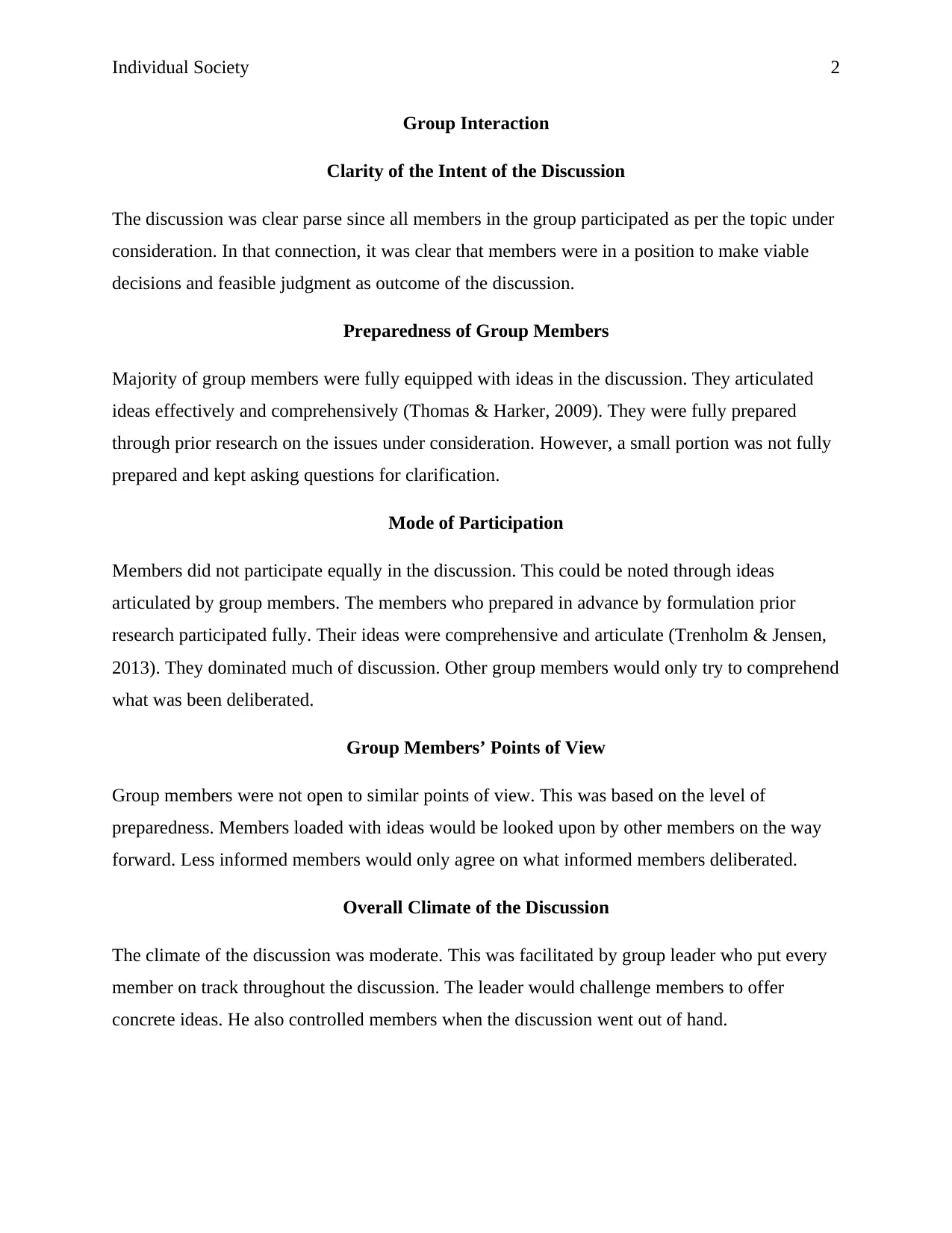
Individual Society 2
Group Interaction
Clarity of the Intent of the Discussion
The discussion was clear parse since all members in the group participated as per the topic under
consideration. In that connection, it was clear that members were in a position to make viable
decisions and feasible judgment as outcome of the discussion.
Preparedness of Group Members
Majority of group members were fully equipped with ideas in the discussion. They articulated
ideas effectively and comprehensively (Thomas & Harker, 2009). They were fully prepared
through prior research on the issues under consideration. However, a small portion was not fully
prepared and kept asking questions for clarification.
Mode of Participation
Members did not participate equally in the discussion. This could be noted through ideas
articulated by group members. The members who prepared in advance by formulation prior
research participated fully. Their ideas were comprehensive and articulate (Trenholm & Jensen,
2013). They dominated much of discussion. Other group members would only try to comprehend
what was been deliberated.
Group Members’ Points of View
Group members were not open to similar points of view. This was based on the level of
preparedness. Members loaded with ideas would be looked upon by other members on the way
forward. Less informed members would only agree on what informed members deliberated.
Overall Climate of the Discussion
The climate of the discussion was moderate. This was facilitated by group leader who put every
member on track throughout the discussion. The leader would challenge members to offer
concrete ideas. He also controlled members when the discussion went out of hand.
Group Interaction
Clarity of the Intent of the Discussion
The discussion was clear parse since all members in the group participated as per the topic under
consideration. In that connection, it was clear that members were in a position to make viable
decisions and feasible judgment as outcome of the discussion.
Preparedness of Group Members
Majority of group members were fully equipped with ideas in the discussion. They articulated
ideas effectively and comprehensively (Thomas & Harker, 2009). They were fully prepared
through prior research on the issues under consideration. However, a small portion was not fully
prepared and kept asking questions for clarification.
Mode of Participation
Members did not participate equally in the discussion. This could be noted through ideas
articulated by group members. The members who prepared in advance by formulation prior
research participated fully. Their ideas were comprehensive and articulate (Trenholm & Jensen,
2013). They dominated much of discussion. Other group members would only try to comprehend
what was been deliberated.
Group Members’ Points of View
Group members were not open to similar points of view. This was based on the level of
preparedness. Members loaded with ideas would be looked upon by other members on the way
forward. Less informed members would only agree on what informed members deliberated.
Overall Climate of the Discussion
The climate of the discussion was moderate. This was facilitated by group leader who put every
member on track throughout the discussion. The leader would challenge members to offer
concrete ideas. He also controlled members when the discussion went out of hand.
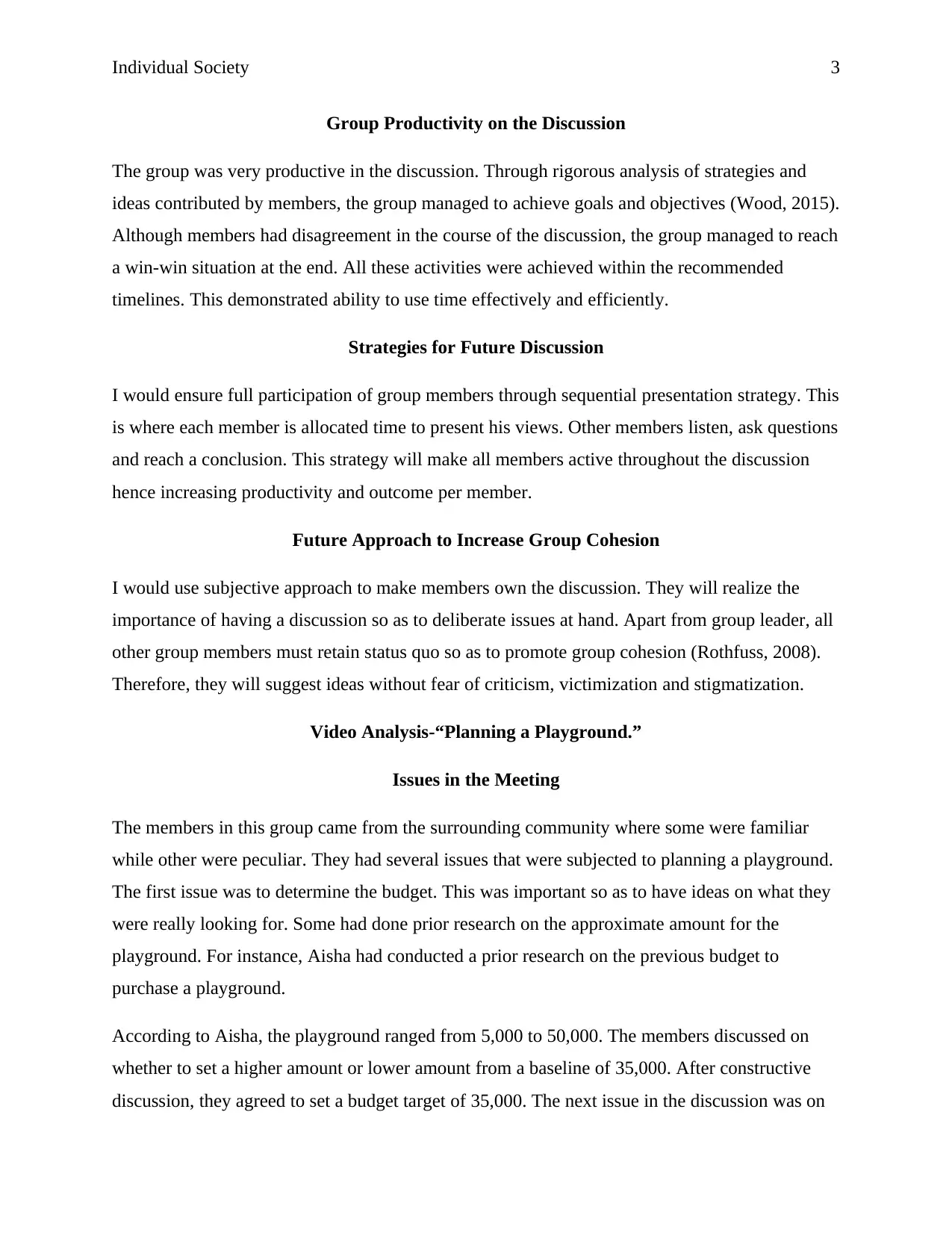
Individual Society 3
Group Productivity on the Discussion
The group was very productive in the discussion. Through rigorous analysis of strategies and
ideas contributed by members, the group managed to achieve goals and objectives (Wood, 2015).
Although members had disagreement in the course of the discussion, the group managed to reach
a win-win situation at the end. All these activities were achieved within the recommended
timelines. This demonstrated ability to use time effectively and efficiently.
Strategies for Future Discussion
I would ensure full participation of group members through sequential presentation strategy. This
is where each member is allocated time to present his views. Other members listen, ask questions
and reach a conclusion. This strategy will make all members active throughout the discussion
hence increasing productivity and outcome per member.
Future Approach to Increase Group Cohesion
I would use subjective approach to make members own the discussion. They will realize the
importance of having a discussion so as to deliberate issues at hand. Apart from group leader, all
other group members must retain status quo so as to promote group cohesion (Rothfuss, 2008).
Therefore, they will suggest ideas without fear of criticism, victimization and stigmatization.
Video Analysis-“Planning a Playground.”
Issues in the Meeting
The members in this group came from the surrounding community where some were familiar
while other were peculiar. They had several issues that were subjected to planning a playground.
The first issue was to determine the budget. This was important so as to have ideas on what they
were really looking for. Some had done prior research on the approximate amount for the
playground. For instance, Aisha had conducted a prior research on the previous budget to
purchase a playground.
According to Aisha, the playground ranged from 5,000 to 50,000. The members discussed on
whether to set a higher amount or lower amount from a baseline of 35,000. After constructive
discussion, they agreed to set a budget target of 35,000. The next issue in the discussion was on
Group Productivity on the Discussion
The group was very productive in the discussion. Through rigorous analysis of strategies and
ideas contributed by members, the group managed to achieve goals and objectives (Wood, 2015).
Although members had disagreement in the course of the discussion, the group managed to reach
a win-win situation at the end. All these activities were achieved within the recommended
timelines. This demonstrated ability to use time effectively and efficiently.
Strategies for Future Discussion
I would ensure full participation of group members through sequential presentation strategy. This
is where each member is allocated time to present his views. Other members listen, ask questions
and reach a conclusion. This strategy will make all members active throughout the discussion
hence increasing productivity and outcome per member.
Future Approach to Increase Group Cohesion
I would use subjective approach to make members own the discussion. They will realize the
importance of having a discussion so as to deliberate issues at hand. Apart from group leader, all
other group members must retain status quo so as to promote group cohesion (Rothfuss, 2008).
Therefore, they will suggest ideas without fear of criticism, victimization and stigmatization.
Video Analysis-“Planning a Playground.”
Issues in the Meeting
The members in this group came from the surrounding community where some were familiar
while other were peculiar. They had several issues that were subjected to planning a playground.
The first issue was to determine the budget. This was important so as to have ideas on what they
were really looking for. Some had done prior research on the approximate amount for the
playground. For instance, Aisha had conducted a prior research on the previous budget to
purchase a playground.
According to Aisha, the playground ranged from 5,000 to 50,000. The members discussed on
whether to set a higher amount or lower amount from a baseline of 35,000. After constructive
discussion, they agreed to set a budget target of 35,000. The next issue in the discussion was on
⊘ This is a preview!⊘
Do you want full access?
Subscribe today to unlock all pages.

Trusted by 1+ million students worldwide
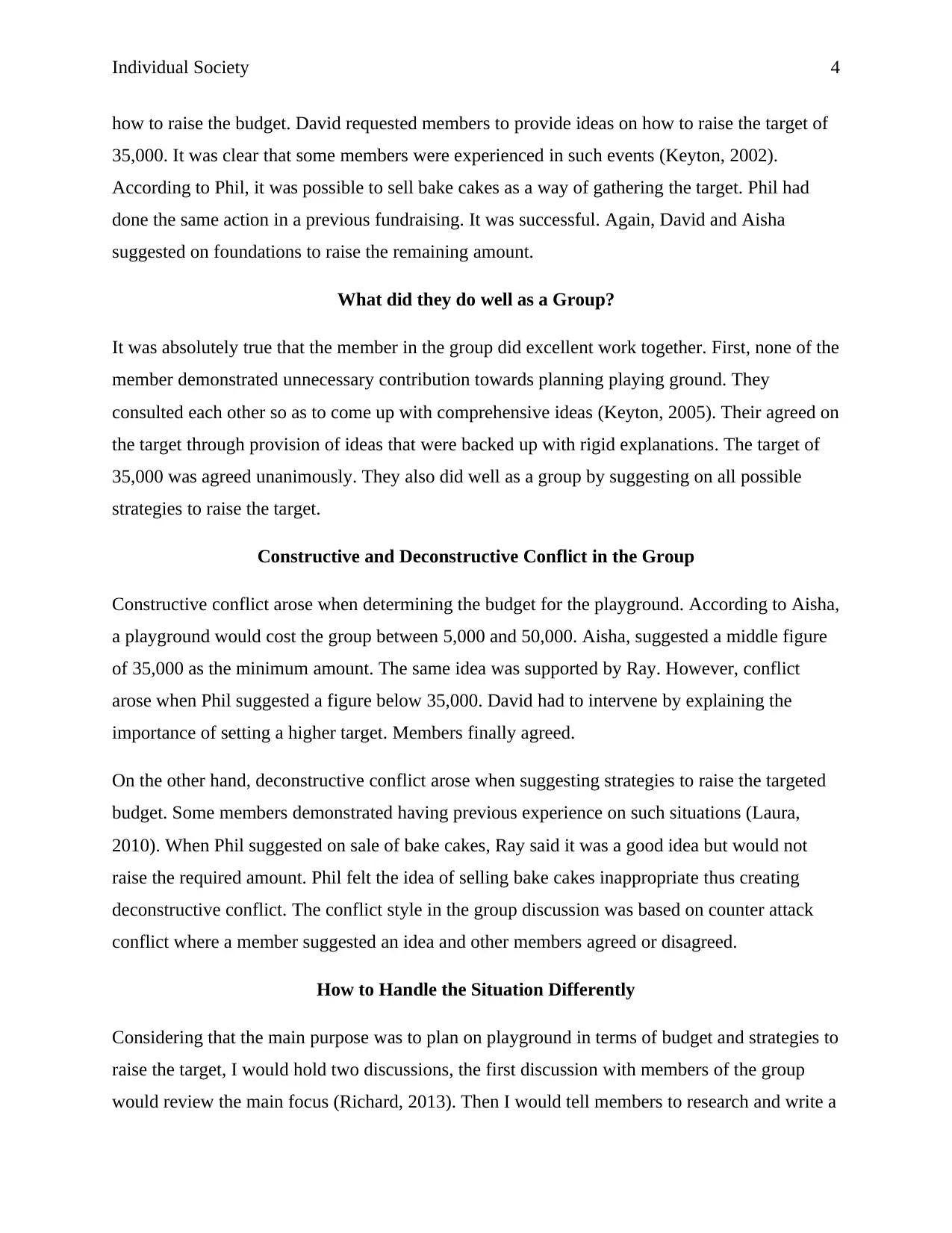
Individual Society 4
how to raise the budget. David requested members to provide ideas on how to raise the target of
35,000. It was clear that some members were experienced in such events (Keyton, 2002).
According to Phil, it was possible to sell bake cakes as a way of gathering the target. Phil had
done the same action in a previous fundraising. It was successful. Again, David and Aisha
suggested on foundations to raise the remaining amount.
What did they do well as a Group?
It was absolutely true that the member in the group did excellent work together. First, none of the
member demonstrated unnecessary contribution towards planning playing ground. They
consulted each other so as to come up with comprehensive ideas (Keyton, 2005). Their agreed on
the target through provision of ideas that were backed up with rigid explanations. The target of
35,000 was agreed unanimously. They also did well as a group by suggesting on all possible
strategies to raise the target.
Constructive and Deconstructive Conflict in the Group
Constructive conflict arose when determining the budget for the playground. According to Aisha,
a playground would cost the group between 5,000 and 50,000. Aisha, suggested a middle figure
of 35,000 as the minimum amount. The same idea was supported by Ray. However, conflict
arose when Phil suggested a figure below 35,000. David had to intervene by explaining the
importance of setting a higher target. Members finally agreed.
On the other hand, deconstructive conflict arose when suggesting strategies to raise the targeted
budget. Some members demonstrated having previous experience on such situations (Laura,
2010). When Phil suggested on sale of bake cakes, Ray said it was a good idea but would not
raise the required amount. Phil felt the idea of selling bake cakes inappropriate thus creating
deconstructive conflict. The conflict style in the group discussion was based on counter attack
conflict where a member suggested an idea and other members agreed or disagreed.
How to Handle the Situation Differently
Considering that the main purpose was to plan on playground in terms of budget and strategies to
raise the target, I would hold two discussions, the first discussion with members of the group
would review the main focus (Richard, 2013). Then I would tell members to research and write a
how to raise the budget. David requested members to provide ideas on how to raise the target of
35,000. It was clear that some members were experienced in such events (Keyton, 2002).
According to Phil, it was possible to sell bake cakes as a way of gathering the target. Phil had
done the same action in a previous fundraising. It was successful. Again, David and Aisha
suggested on foundations to raise the remaining amount.
What did they do well as a Group?
It was absolutely true that the member in the group did excellent work together. First, none of the
member demonstrated unnecessary contribution towards planning playing ground. They
consulted each other so as to come up with comprehensive ideas (Keyton, 2005). Their agreed on
the target through provision of ideas that were backed up with rigid explanations. The target of
35,000 was agreed unanimously. They also did well as a group by suggesting on all possible
strategies to raise the target.
Constructive and Deconstructive Conflict in the Group
Constructive conflict arose when determining the budget for the playground. According to Aisha,
a playground would cost the group between 5,000 and 50,000. Aisha, suggested a middle figure
of 35,000 as the minimum amount. The same idea was supported by Ray. However, conflict
arose when Phil suggested a figure below 35,000. David had to intervene by explaining the
importance of setting a higher target. Members finally agreed.
On the other hand, deconstructive conflict arose when suggesting strategies to raise the targeted
budget. Some members demonstrated having previous experience on such situations (Laura,
2010). When Phil suggested on sale of bake cakes, Ray said it was a good idea but would not
raise the required amount. Phil felt the idea of selling bake cakes inappropriate thus creating
deconstructive conflict. The conflict style in the group discussion was based on counter attack
conflict where a member suggested an idea and other members agreed or disagreed.
How to Handle the Situation Differently
Considering that the main purpose was to plan on playground in terms of budget and strategies to
raise the target, I would hold two discussions, the first discussion with members of the group
would review the main focus (Richard, 2013). Then I would tell members to research and write a
Paraphrase This Document
Need a fresh take? Get an instant paraphrase of this document with our AI Paraphraser
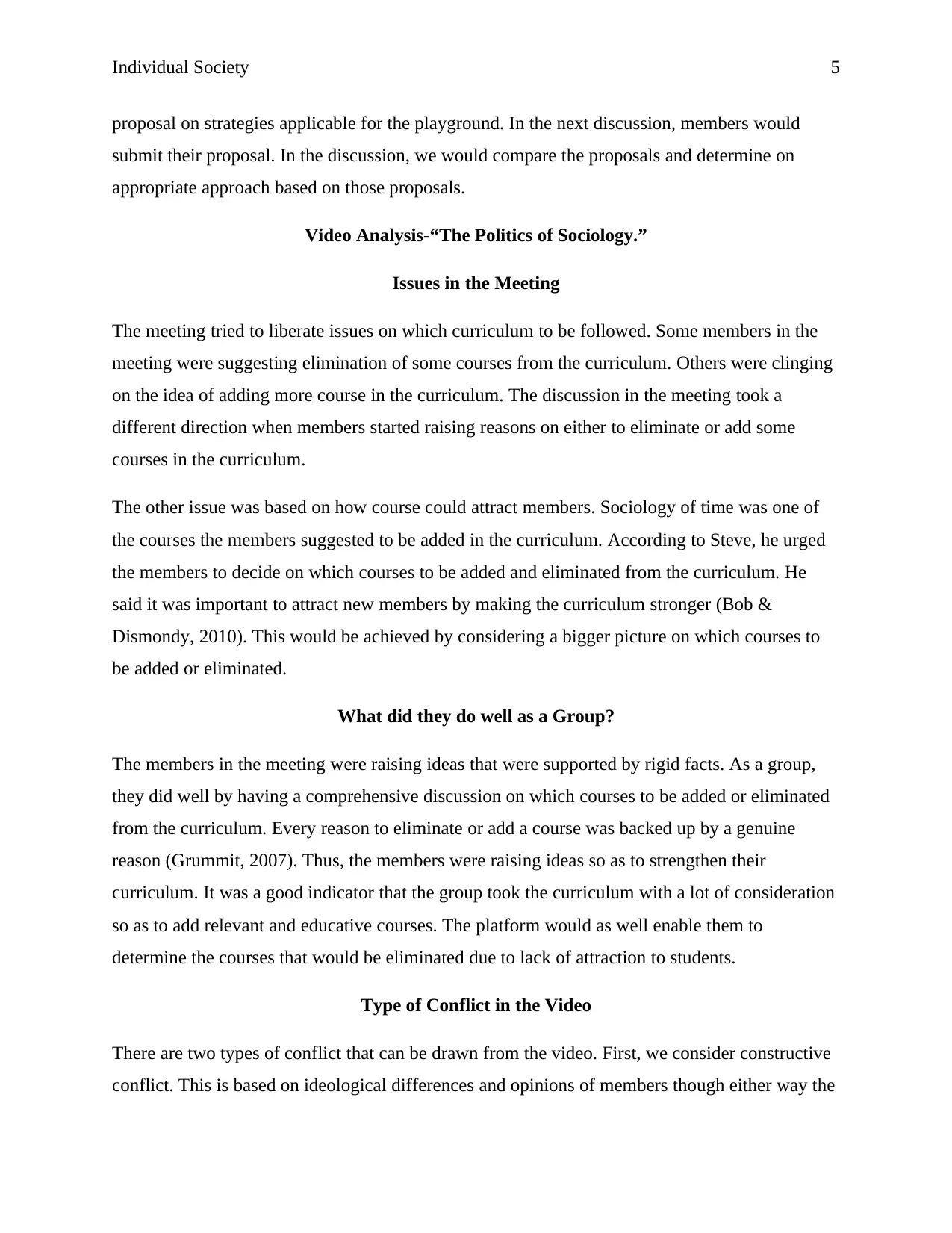
Individual Society 5
proposal on strategies applicable for the playground. In the next discussion, members would
submit their proposal. In the discussion, we would compare the proposals and determine on
appropriate approach based on those proposals.
Video Analysis-“The Politics of Sociology.”
Issues in the Meeting
The meeting tried to liberate issues on which curriculum to be followed. Some members in the
meeting were suggesting elimination of some courses from the curriculum. Others were clinging
on the idea of adding more course in the curriculum. The discussion in the meeting took a
different direction when members started raising reasons on either to eliminate or add some
courses in the curriculum.
The other issue was based on how course could attract members. Sociology of time was one of
the courses the members suggested to be added in the curriculum. According to Steve, he urged
the members to decide on which courses to be added and eliminated from the curriculum. He
said it was important to attract new members by making the curriculum stronger (Bob &
Dismondy, 2010). This would be achieved by considering a bigger picture on which courses to
be added or eliminated.
What did they do well as a Group?
The members in the meeting were raising ideas that were supported by rigid facts. As a group,
they did well by having a comprehensive discussion on which courses to be added or eliminated
from the curriculum. Every reason to eliminate or add a course was backed up by a genuine
reason (Grummit, 2007). Thus, the members were raising ideas so as to strengthen their
curriculum. It was a good indicator that the group took the curriculum with a lot of consideration
so as to add relevant and educative courses. The platform would as well enable them to
determine the courses that would be eliminated due to lack of attraction to students.
Type of Conflict in the Video
There are two types of conflict that can be drawn from the video. First, we consider constructive
conflict. This is based on ideological differences and opinions of members though either way the
proposal on strategies applicable for the playground. In the next discussion, members would
submit their proposal. In the discussion, we would compare the proposals and determine on
appropriate approach based on those proposals.
Video Analysis-“The Politics of Sociology.”
Issues in the Meeting
The meeting tried to liberate issues on which curriculum to be followed. Some members in the
meeting were suggesting elimination of some courses from the curriculum. Others were clinging
on the idea of adding more course in the curriculum. The discussion in the meeting took a
different direction when members started raising reasons on either to eliminate or add some
courses in the curriculum.
The other issue was based on how course could attract members. Sociology of time was one of
the courses the members suggested to be added in the curriculum. According to Steve, he urged
the members to decide on which courses to be added and eliminated from the curriculum. He
said it was important to attract new members by making the curriculum stronger (Bob &
Dismondy, 2010). This would be achieved by considering a bigger picture on which courses to
be added or eliminated.
What did they do well as a Group?
The members in the meeting were raising ideas that were supported by rigid facts. As a group,
they did well by having a comprehensive discussion on which courses to be added or eliminated
from the curriculum. Every reason to eliminate or add a course was backed up by a genuine
reason (Grummit, 2007). Thus, the members were raising ideas so as to strengthen their
curriculum. It was a good indicator that the group took the curriculum with a lot of consideration
so as to add relevant and educative courses. The platform would as well enable them to
determine the courses that would be eliminated due to lack of attraction to students.
Type of Conflict in the Video
There are two types of conflict that can be drawn from the video. First, we consider constructive
conflict. This is based on ideological differences and opinions of members though either way the
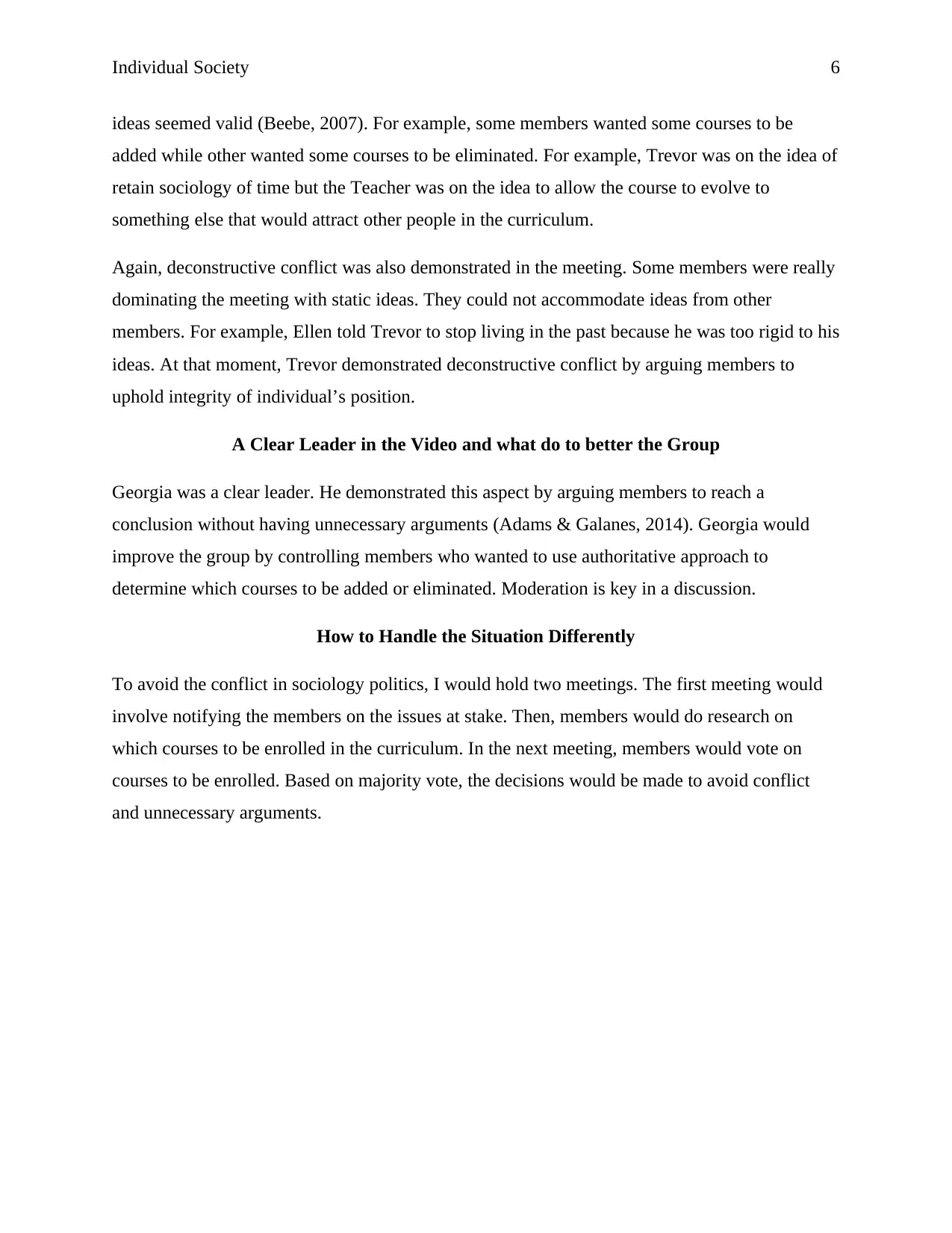
Individual Society 6
ideas seemed valid (Beebe, 2007). For example, some members wanted some courses to be
added while other wanted some courses to be eliminated. For example, Trevor was on the idea of
retain sociology of time but the Teacher was on the idea to allow the course to evolve to
something else that would attract other people in the curriculum.
Again, deconstructive conflict was also demonstrated in the meeting. Some members were really
dominating the meeting with static ideas. They could not accommodate ideas from other
members. For example, Ellen told Trevor to stop living in the past because he was too rigid to his
ideas. At that moment, Trevor demonstrated deconstructive conflict by arguing members to
uphold integrity of individual’s position.
A Clear Leader in the Video and what do to better the Group
Georgia was a clear leader. He demonstrated this aspect by arguing members to reach a
conclusion without having unnecessary arguments (Adams & Galanes, 2014). Georgia would
improve the group by controlling members who wanted to use authoritative approach to
determine which courses to be added or eliminated. Moderation is key in a discussion.
How to Handle the Situation Differently
To avoid the conflict in sociology politics, I would hold two meetings. The first meeting would
involve notifying the members on the issues at stake. Then, members would do research on
which courses to be enrolled in the curriculum. In the next meeting, members would vote on
courses to be enrolled. Based on majority vote, the decisions would be made to avoid conflict
and unnecessary arguments.
ideas seemed valid (Beebe, 2007). For example, some members wanted some courses to be
added while other wanted some courses to be eliminated. For example, Trevor was on the idea of
retain sociology of time but the Teacher was on the idea to allow the course to evolve to
something else that would attract other people in the curriculum.
Again, deconstructive conflict was also demonstrated in the meeting. Some members were really
dominating the meeting with static ideas. They could not accommodate ideas from other
members. For example, Ellen told Trevor to stop living in the past because he was too rigid to his
ideas. At that moment, Trevor demonstrated deconstructive conflict by arguing members to
uphold integrity of individual’s position.
A Clear Leader in the Video and what do to better the Group
Georgia was a clear leader. He demonstrated this aspect by arguing members to reach a
conclusion without having unnecessary arguments (Adams & Galanes, 2014). Georgia would
improve the group by controlling members who wanted to use authoritative approach to
determine which courses to be added or eliminated. Moderation is key in a discussion.
How to Handle the Situation Differently
To avoid the conflict in sociology politics, I would hold two meetings. The first meeting would
involve notifying the members on the issues at stake. Then, members would do research on
which courses to be enrolled in the curriculum. In the next meeting, members would vote on
courses to be enrolled. Based on majority vote, the decisions would be made to avoid conflict
and unnecessary arguments.
⊘ This is a preview!⊘
Do you want full access?
Subscribe today to unlock all pages.

Trusted by 1+ million students worldwide
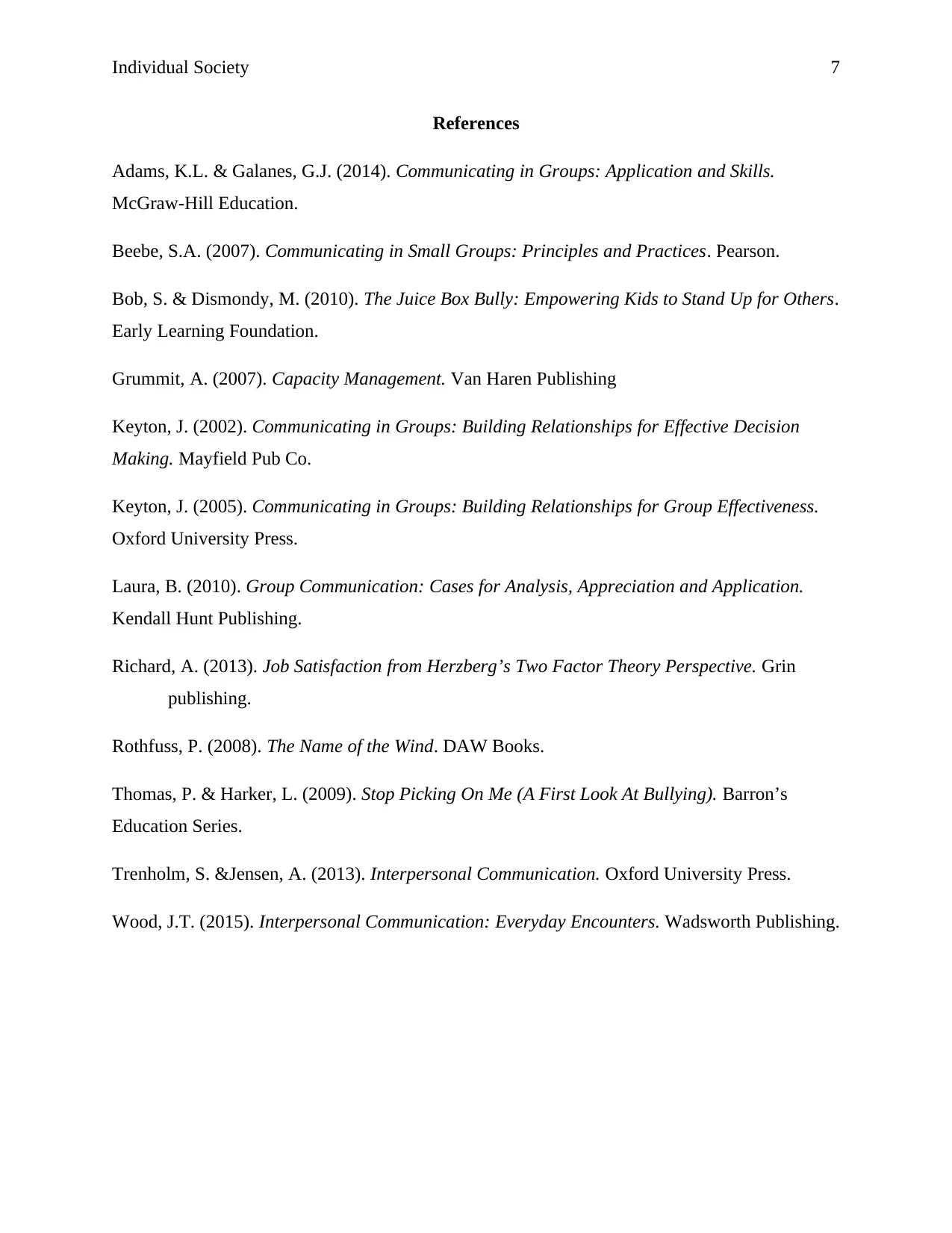
Individual Society 7
References
Adams, K.L. & Galanes, G.J. (2014). Communicating in Groups: Application and Skills.
McGraw-Hill Education.
Beebe, S.A. (2007). Communicating in Small Groups: Principles and Practices. Pearson.
Bob, S. & Dismondy, M. (2010). The Juice Box Bully: Empowering Kids to Stand Up for Others.
Early Learning Foundation.
Grummit, A. (2007). Capacity Management. Van Haren Publishing
Keyton, J. (2002). Communicating in Groups: Building Relationships for Effective Decision
Making. Mayfield Pub Co.
Keyton, J. (2005). Communicating in Groups: Building Relationships for Group Effectiveness.
Oxford University Press.
Laura, B. (2010). Group Communication: Cases for Analysis, Appreciation and Application.
Kendall Hunt Publishing.
Richard, A. (2013). Job Satisfaction from Herzberg’s Two Factor Theory Perspective. Grin
publishing.
Rothfuss, P. (2008). The Name of the Wind. DAW Books.
Thomas, P. & Harker, L. (2009). Stop Picking On Me (A First Look At Bullying). Barron’s
Education Series.
Trenholm, S. &Jensen, A. (2013). Interpersonal Communication. Oxford University Press.
Wood, J.T. (2015). Interpersonal Communication: Everyday Encounters. Wadsworth Publishing.
References
Adams, K.L. & Galanes, G.J. (2014). Communicating in Groups: Application and Skills.
McGraw-Hill Education.
Beebe, S.A. (2007). Communicating in Small Groups: Principles and Practices. Pearson.
Bob, S. & Dismondy, M. (2010). The Juice Box Bully: Empowering Kids to Stand Up for Others.
Early Learning Foundation.
Grummit, A. (2007). Capacity Management. Van Haren Publishing
Keyton, J. (2002). Communicating in Groups: Building Relationships for Effective Decision
Making. Mayfield Pub Co.
Keyton, J. (2005). Communicating in Groups: Building Relationships for Group Effectiveness.
Oxford University Press.
Laura, B. (2010). Group Communication: Cases for Analysis, Appreciation and Application.
Kendall Hunt Publishing.
Richard, A. (2013). Job Satisfaction from Herzberg’s Two Factor Theory Perspective. Grin
publishing.
Rothfuss, P. (2008). The Name of the Wind. DAW Books.
Thomas, P. & Harker, L. (2009). Stop Picking On Me (A First Look At Bullying). Barron’s
Education Series.
Trenholm, S. &Jensen, A. (2013). Interpersonal Communication. Oxford University Press.
Wood, J.T. (2015). Interpersonal Communication: Everyday Encounters. Wadsworth Publishing.
1 out of 7
Your All-in-One AI-Powered Toolkit for Academic Success.
+13062052269
info@desklib.com
Available 24*7 on WhatsApp / Email
![[object Object]](/_next/static/media/star-bottom.7253800d.svg)
Unlock your academic potential
Copyright © 2020–2025 A2Z Services. All Rights Reserved. Developed and managed by ZUCOL.
